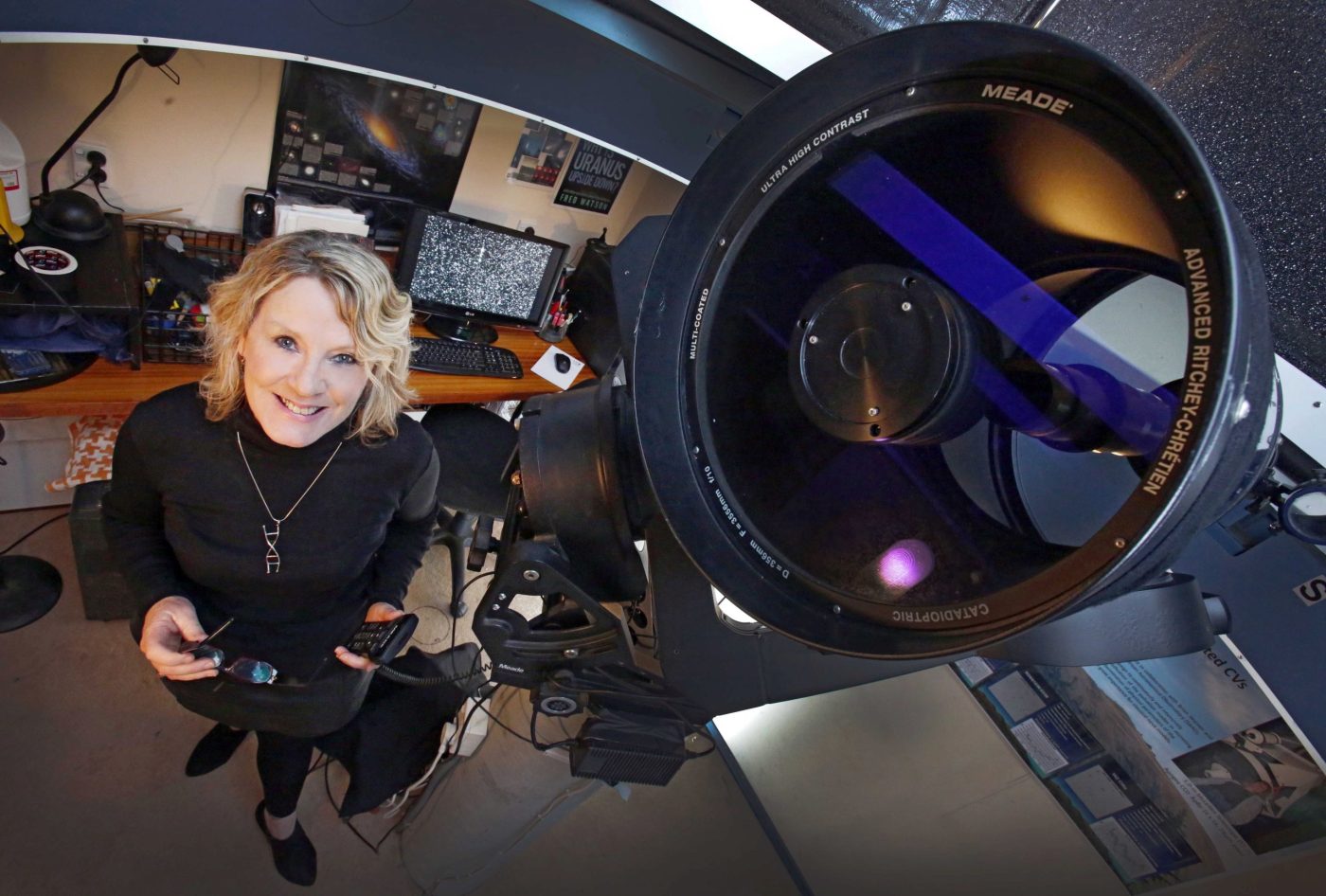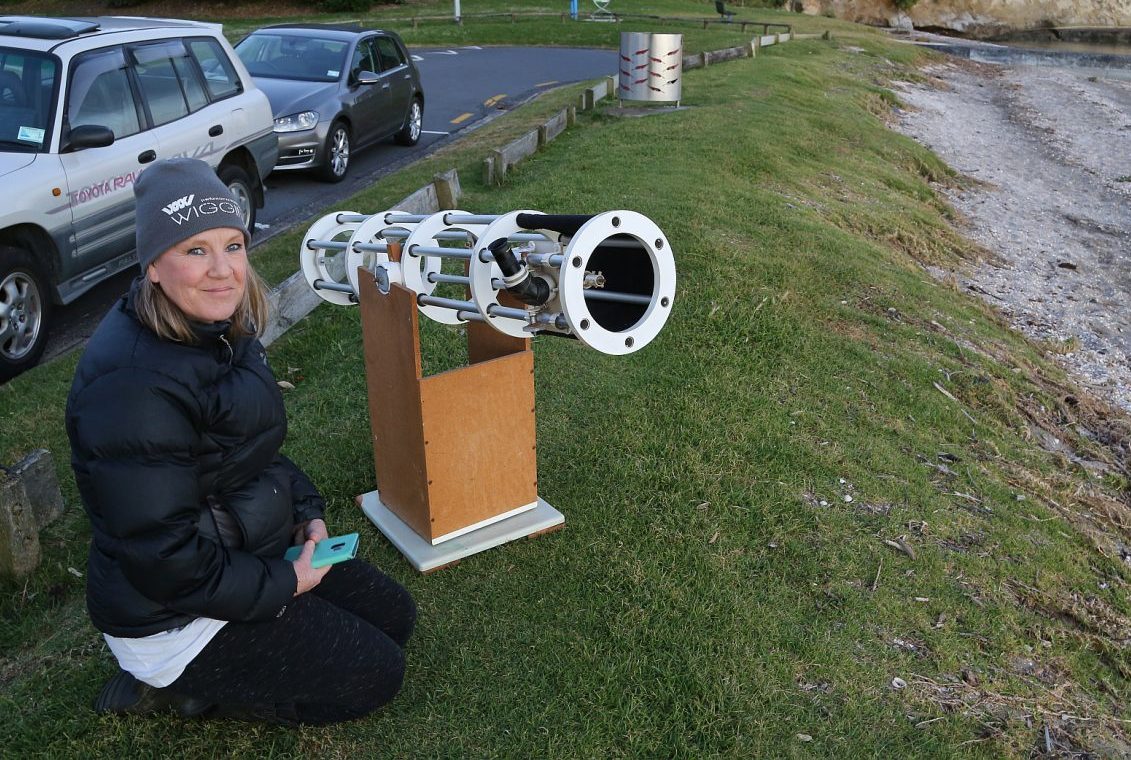|
Getting your Trinity Audio player ready...
|

The self-made world-class astronomer and community houses manager talks to PJ TAYLOR about her amazing galactic journey.
Where were you born and grew up?
In the North Island city with the longest navigable waterway, Wanganui. Spent my childhood there and left when I was 15 for the bright lights of Auckland with my mother, sisters and brother.
You’re an astronomer and have the Farm Cove Observatory. How did you become involved in astronomy?
I’ve always loved the night sky and my earliest memory of this was when I was very young. Light pollution was nothing like it is today and night skies then were guaranteed to be very dark. When the sky was clear, it filled with fabulous jewel-like stars. These nights stoked my passion for astronomy and anything to do with space. Once I started watching Lost in Space and Star Trek on our new black and white TV, I became lost in space myself.
Years later, I was looking through our community newspaper in south Auckland and came across an article advertising a meeting at the Auckland Observatory. It mentioned an upcoming lecture on the solar system which included telescope viewing. After attending and being wowed by the views through the telescopes, I decided to join the Auckland Astronomical Society. I learnt about the night sky, how to find interesting objects using star charts and telescopes, spending hours in the dark with people sharing the same interest. I attended many dark sky camps, meetings, courses and talks and found my interest in astronomy was really taking off.
I started my own business called AstroKids where I travelled around schools in Auckland and attended numerous school camps. I was teaching and hoped, inspiring children and adults, in the science of astronomy. In the end, Auckland Observatory employed me as one of its full-time educators. I stayed for about 15 years until, unfortunately, its ethos changed. During my time at Auckland Observatory, I was able to build my own observatory at home and called it Farm Cove Observatory or FCO for short.
With my own observatory I was able to start collaborating with overseas universities in astronomical research areas. Having my own observatory and equipment meant I had uninterrupted telescope time and could take part and contribute to areas of astronomical science I found interesting. One area was hunting extra solar planets in other solar systems, known as gravitational microlensing.
I worked with a group known as MicroFUN from Ohio State University. It was within this collaboration I had my first really big success. In 2005, I produced data from my observatory (the smallest amateur telescope in the collaboration at the time) that showed direct evidence of a three-times Jupiter mass planet orbiting a star some 11,000 light years towards our Milky Way galaxy’s centre. The event was known as OGLE-2005-BLG-071L and rather excitingly, it was listed as one of the top 10 news items in the year of astronomy 2005.
The success with the MicroFUN collaboration was out of this world. We were not only discovering new planets, but new solar systems too. Many hours were spent at the telescope, and it was incredible to be part of research success, but more importantly to be making a contribution to the science of astronomy.
You received a New Zealand Honours List recognition for services to astronomy. How did you feel getting it?
In 2006, I received the Member for New Zealand Order of Merit (MNZM) for services to astronomy. I remember coming home one afternoon, checking the letterbox and finding a very smart professional looking envelope inside. It certainly wasn’t like any other letter I had received. It was the whitest white I had ever seen and the thickest and velvety envelope I think I have ever touched. It was very surreal. I rang my mum and told her, even though the letter said not to tell anyone, just yet. I felt extremely honoured to receive such recognition, it was a huge shock. I certainly never gave such awards any thought. I also felt somewhat embarrassed as I was just doing something I loved and valued. I just hoped the contributions I was making in astronomy was going some way to helping with the understanding of the universe we live in.
Decades ago, when looking up at the night sky, it was rare to see a flying/moving lit object, leading to talk about UFOs. Nowadays, every time I gaze skyward in the dark, something’s moving.
Back in those days we would say, “look there is a shooting star” or “look, there is a UFO!” I remember clearly seeing what I thought were shooting stars. What I didn’t know then was, they were not stars at all, in fact they were meteors, pieces of leftover solar system debris, entering the atmosphere and burning up. My mum and dad while parked up at Castlecliff Beach [Wanganui] in the early 1960s thought they had seen a UFO, as did others including the local newspaper reporters, but it turned out to be atmospheric nuclear testing from Christmas Island. Most of the objects we see today are either asteroid or cometary debris from the early solar system formation, meteors, fireballs etc burning up in the atmosphere, or human made artificial satellites in orbit around the Earth. There are many artificial satellites orbiting our planet. Unfortunately, they’re becoming more frequent which has a negative effect on astronomers and astrophotographers. Our beautiful night sky is becoming littered with them, as they basically pollute our night sky environment.

What sort of work routine is involved with your observatory?
When I get home from work and the weather is clear, I’ll get the observatory and equipment operational. It really all depends on what projects are taking place and what I’ve been asked to look at. Lately I’ve been imaging asteroids for a research programme regarding asteroid rotational periods. I regularly image comets, asteroids and near-Earth objects for positional data and information for the Minor Planet Centre. In winter when the Galactic Bulge (the centre of our galaxy) is high above New Zealand, I’ll take part in gravitational microlensing events looking for extra solar planets. From time to time when the sky is clear for longer periods, I’ll take data on cataclysmic variable stars for the CBA (Centre for Backyard Astrophysics). There’s always something interesting to do and you never know what you’re going to find.
You also work as manager for the Highland Park and Anchorage Park Community Houses. What does that involve?
Making sure our two community houses are operating well and servicing our community needs, from community activities and interest groups to services and clinics that contribute to a holistic sense of well-being. It’s important the houses are fit for purpose, for example, community groups and business room hire. That both houses are comfortable, clean and affordable and that we have created a welcoming and inclusive atmosphere for all people. Both houses are operated by the Howick and Pakuranga Community Houses Inc Society and supported and funded by Auckland Council and the Howick Local Board.
What are the more important social issues in the east community that need addressing?
Having a safe environment for our families to live and prosper. There appears to be an increase in violence and theft where people are being robbed and their property stolen and damaged. These issues need to be addressed and the people doing this antisocial behaviour need to be brought to justice and see there are serious consequences for their actions.
Away from work and telescopes, what are your favourite things to do in east Auckland?
Exploring our beautiful reserves, parks, beaches and regional parks with my friends and family. Doing my best to look after our valuable native birdlife by proactively working towards pest control in my area. We’re all so lucky to live in such a beautiful part of Auckland. Let’s get to know it and look after it.
If there was anything you’d like changed in New Zealand society what would it be?
More thought and scientific process should be going into educating the light pollution generated by our lighting engineers. Very poor street lighting and business lighting is causing major problems in our environment. This needs urgent addressing. Proper lighting standards should be met to protect our outdoor evening environments for all of us living on this planet we call home.








